The Over-Strength Coefficient of Masonry-Infilled RC Frame Structures under Bidirectional Ground Motions
Abstract
:1. Introduction
2. Design of Masonry-Infilled RC Frame Structures
3. Finite element Modeling Technology
3.1. Modeling of Frames and Infill Walls
3.2. Verification of Finite Element Modeling
4. Ground Motions
5. Over-Strength Coefficient Capacity Analysis
5.1. Introduction of Over-Strength Coefficient Capacity Analysis
- (1)
- Perform incremental dynamic analysis (IDA) of the model under one pair of ground motion, obtain the maximum inter-story drift ratio under different ground motion levels, and plot the IDA curve of the model under this pair of ground motion.
- (2)
- Obtain the structural dynamic capacity curve in the form of maximum base shear force (Vmax) and maximum top displacement (∆max), then transform the dynamic capacity curve into a double-linear elastic–plastic curve by using the equal energy principle, and solve the equivalent yielding strength Vy of the structure.
- (3)
- Calculate the design seismic force Vd of the structure by using the bottom shear method or the mode-superposition response spectrum method.
- (4)
- Calculate the system over-strength coefficient Rs by its definition as shown in Formula (4).
- (5)
- Repeat the above steps to obtain the system over-strength coefficient under each pair of ground motion.
- (6)
- Take the median value as the system over-strength coefficient capacity value.
5.2. Over-Strength Coefficient Capacity Analysis of Infilled RC Frame Structure
6. The Assessment of Over-Strength Coefficient
- (1)
- Develop the structural dynamic capacity curve of the model under one pair of ground motion; then, convert the structural capacity curve into the spectral acceleration-displacement curve, that is, the capacity spectrum curve.
- (2)
- Convert the seismic response spectrum with 5% damping into the spectral displacement–acceleration format as well, that is, the demand spectrum curve.
- (3)
- Solve the intersection of the capacity spectrum and demand spectrum curves by using the dynamic capability spectrum method; then, obtain the target vertex displacement Δe and the corresponding base shear force Vy under different strength spectra.
- (4)
- Knowing the seismic design force Vd of the structure, according to Formula (4), calculate the demand value of the over-strength coefficient at different strength spectra.
- (5)
- Calculate the over-strength coefficient capacity–demand ratio of the structure according to the following formula.
- (6)
- Repeat the above steps to obtain the demand values and capacity–demand ratios of the system over-strength coefficient under each pair of ground motions.
- (7)
- Take the median values as the demand value and capacity–demand ratio of the system over-strength coefficient.
7. Conclusions
Author Contributions
Funding
Institutional Review Board Statement
Informed Consent Statement
Data Availability Statement
Acknowledgments
Conflicts of Interest
References
- Applied Technology Council. Quantification of Building Seismic Performance Factors; US Department of Homeland Security, FEMA: Washington, DC, USA, 2009. [Google Scholar]
- International Conference of Building Officials. Uniform building code. In Proceedings of the International Conference of Building Officials, Whittier, CA, USA, 18–21 October 1927. [Google Scholar]
- Kandel, S.; Suwal, D.R. Effect of Building Configuration on Overstrength Factor and Ductility Factor. Eng. Technol. Q. Rev. 2021, 4, 10–18. [Google Scholar] [CrossRef]
- Qazi, A.U.; Rasool, A.M.; Ibrahim, Y.E.; Hameed, A.; Ali, M.F. Behavior of Scaled Infilled Masonry, Confined Masonry & Reinforced Concrete Structures under Dynamic Excitations. Buildings 2022, 12, 774. [Google Scholar] [CrossRef]
- Khan, N.A.; Monti, G.; Nuti, C.; Vailati, M. Effects of infills in the seismic performance of an RC factory building in Pakistan. Buildings 2021, 11, 276. [Google Scholar] [CrossRef]
- Almasabha, G.; Alshboul, O.; Shehadeh, A.; Almuflih, A.S. Machine Learning Algorithm for Shear Strength Prediction of Short Links for Steel Buildings. Buildings 2022, 12, 775. [Google Scholar] [CrossRef]
- Manganiello, L.; Montuori, R.; Nastri, E.; Piluso, V. The influence of the axial restraint on the overstrength of short links. J. Constr. Steel Res. 2021, 184, 106758. [Google Scholar] [CrossRef]
- Abraik, E.; Youssef, M.A. Ductility and overstrength of shape-memory-alloy reinforced-concrete shear walls. Eng. Struct. 2021, 239, 112236. [Google Scholar] [CrossRef]
- Osteraas, J.; Krawinkler, H. Strength and Ductility Considerations in Seismic Design. John A. Blume Earthquake Engineering Center Technical Report 90. Stanford Digital Repository. Stanford University. 1990. Available online: http://purl.stanford.edu/cb239mm7088 (accessed on 16 July 2022).
- Rahgozar, M.; Humar, J. Accounting for overstrength in seismic design of steel structures. Can. J. Civ. Eng. 1998, 25, 1–15. [Google Scholar] [CrossRef]
- Calderoni, B.; Ghersi, A.; Rinaldi, Z. Statistical analysis of seismic behaviour of steel frames: Influence of overstrength. J. Constr. Steel Res. 1996, 39, 137–161. [Google Scholar] [CrossRef] [Green Version]
- Balendra, T.; Huang, X. Overstrength and ductility factors for steel frames designed according to BS 5950. J. Struct. Eng. 2003, 129, 1019–1035. [Google Scholar] [CrossRef]
- De Stefano, M.; Marino, E.M.; Rossi, P.P. Effect of overstrength on the seismic behaviour of multi-storey regularly asymmetric buildings. Bull. Earthq. Eng. 2006, 4, 23–42. [Google Scholar] [CrossRef]
- Rossi, P.; Lombardo, A. Influence of the link overstrength factor on the seismic behaviour of eccentrically braced frames. J. Constr. Steel Res. 2007, 63, 1529–1545. [Google Scholar] [CrossRef]
- Wei, F.; Li, G.; Bai, S. Design specifications of various countries on the basis of seismic fortification and structural over-strength consideration. J. Chongqing Univ. (Nat. Sci. Ed.) 2007, 30, 102–108. (In Chinese) [Google Scholar]
- Zhai, C.; Xie, L. Study on overstrength of RC frame structures. Jianzhu Jiegou Xuebao J. Build. Struct. 2007, 28, 101–106. [Google Scholar]
- Zhou, J.; Cai, J.; Fang, X. Seismic overstrength factors for reinforced concrete frames. World Earthq. Eng. 2007, 23, 227–233. [Google Scholar]
- Ma, H.W.; Chao, X.Y. A simplified analytical method for maximum inelastic seismic response of RC frames. Eng. Mech. 2007, 24, 113. (In Chinese) [Google Scholar]
- Xin, L.; Liang, X.W.; Tong, Y.S. Study on the value of design bearing capacity in displacement-based seismic design. J. Earthq. Eng. Enigineering Vib. 2009, 29, 35–41. [Google Scholar]
- Kuşyılmaz, A.; Topkaya, C. Design overstrength of steel eccentrically braced frames. Int. J. Steel Struct. 2013, 13, 529–545. [Google Scholar] [CrossRef]
- Elnashai, A.S.; Mwafy, A.M. Overstrength and force reduction factors of multistorey reinforced-concrete buildings. Struct. Des. Tall Spec. Build. 2002, 11, 329–351. [Google Scholar] [CrossRef]
- Dickof, C.; Stiemer, S.; Bezabeh, M.; Tesfamariam, S. CLT–steel hybrid system: Ductility and overstrength values based on static pushover analysis. J. Perform. Constr. Facil. 2014, 28, A4014012. [Google Scholar] [CrossRef]
- Cui, S.S. Research on Global Seismic Performance Factors and Conprehensive Response Modification Factors of RC Frames Structures. Ph.D. Thesis, Harbin Institute of Technology, Harbin, China, 2013. (In Chinese). [Google Scholar]
- Li, Y.J.; Lv, D.G.; Wang, Z.Y. The overstrength factor of RC frames with infilled walls based on adaptive POA and IDA. Eng. Mech. 2017, 34, 197. [Google Scholar] [CrossRef]
- Johnson, T.P.; Dowell, R.K. Evaluation of the overstrength factor for nonstructural component anchorage into concrete via dynamic shaking table tests. J. Build. Eng. 2017, 11, 205–215. [Google Scholar] [CrossRef]
- Xin, Y.Z. Study on Response Modification Factor for the Steel Grid Box Frame Structure Based on Seismostruct. Master’s Thesis, Southwest Jiaotong University, Chengdu, China, 2018. (In Chinese). [Google Scholar]
- Bai, J.; He, J.; Li, C.; Jin, S.; Yang, H. Experimental investigation on the seismic performance of a novel damage-control replaceable RC beam-to-column joint. Eng. Struct. 2022, 267, 114692. [Google Scholar] [CrossRef]
- Cui, L. Seismic Performance Factors of Infilled RC Frame. Master’s Thesis, Yantai University, Yantai, China, 2022. (In Chinese). [Google Scholar]
- Kong, J.; Su, Y.; Zheng, Z.; Wang, X.; Zhang, Y. The Influence of Vertical Arrangement and Masonry Material of Infill Walls on the Seismic Performance of RC Frames. Buildings 2022, 12, 825. [Google Scholar] [CrossRef]
- Roy, N.S.; Choudhury, S. Seismic Vulnerability Assessment Methods: A Review. In Proceedings of the International Conference on Advances in Structural Mechanics and Applications, Silchar, India, 26–28 March 2021; pp. 282–300. [Google Scholar]
- Oggu, P.; Gopikrishna, K.; Nagariya, A. Seismic behavior and response reduction factors for concrete moment-resisting frames. Bull. Earthq. Eng. 2021, 19, 5643–5663. [Google Scholar] [CrossRef]
- GB50011-2010; Code for Seismic Design of Buildings. China Architecture and Building Press: Beijing, China, 2010.
- Cheng, Y.; Dong, Y.R.; Bai, G.L.; Wang, Y.Y. IDA-based seismic fragility of high-rise frame-core tube structure subjected to multi-dimensional long-period ground motions. J. Build. Eng. 2021, 43, 102917. [Google Scholar] [CrossRef]
- Di Trapani, F.; Sberna, A.P.; Marano, G.C. A new genetic algorithm-based framework for optimized design of steel-jacketing retrofitting in shear-critical and ductility-critical RC frame structures. Eng. Struct. 2021, 243, 112684. [Google Scholar] [CrossRef]
- Huang, W.; Gould, P.L. 3-D pushover analysis of a collapsed reinforced concrete chimney. Finite Elem. Anal. Des. 2007, 43, 879–887. [Google Scholar] [CrossRef]
- Zuo, Z.; He, Y.; Li, S. Rational Use of Idealized Shear-Building Models to Approximate Actual Buildings. Buildings 2022, 12, 273. [Google Scholar] [CrossRef]
- Lowes, L.; Mitra, N.; Altoontash, A. A Beam-Column Joint Model for Simulating the Earthquake Response of Reinforced Concrete Frames. PEER Report 2003/10; University of California, Berkeley: Berkeley, CA, USA, 2004. [Google Scholar]
- Marinković, M.; Butenweg, C. Experimental testing of decoupled masonry infills with steel anchors for out-of-plane support under combined in-plane and out-of-plane seismic loading. Constr. Build. Mater. 2022, 318, 126041. [Google Scholar] [CrossRef]
- Furtado, A.; Rodrigues, H.; Arêde, A. Experimental and numerical assessment of confined infill walls with openings and textile-reinforced mortar. Soil Dyn. Earthq. Eng. 2021, 151, 106960. [Google Scholar] [CrossRef]
- Varum, H.; Furtado, A.; Rodrigues, H.; Dias-Oliveira, J.; Vila-Pouca, N.; Arêde, A. Seismic performance of the infill masonry walls and ambient vibration tests after the Ghorka 2015, Nepal earthquake. Bull. Earthq. Eng. 2017, 15, 1185–1212. [Google Scholar] [CrossRef]
- Furtado, A.; Rodrigues, H.; Arêde, A.; Varum, H. Simplified macro-model for infill masonry walls considering the out-of-plane behaviour. Earthq. Eng. Struct. Dyn. 2016, 45, 507–524. [Google Scholar] [CrossRef]
- Kadysiewski, S.; Mosalam, K.M. Modeling of Unreinforced Masonry Infill Walls Considering in-Plane and out-of-Plane Interaction; Pacific Earthquake Engineering Research Center Berkeley: Berkeley, CA, USA, 2009; Volume 70. [Google Scholar]
- Kurban, C.O.; Topkaya, C. A numerical study on response modification, overstrength, and displacement amplification factors for steel plate shear wall systems. Earthq. Eng. Struct. Dyn. 2009, 38, 497–516. [Google Scholar] [CrossRef]
- Xie, L.; Ye, X.; Chong, X.; Jiang, Q. Parameter research on numerical analysis of low-cyclic loading test of RC columns. China Civ. Eng. J. 2012, 45, 273–277. (In Chinese) [Google Scholar] [CrossRef]
- Hashemi, A.; Mosalam, K.M. Shake-table experiment on reinforced concrete structure containing masonry infill wall. Earthq. Eng. Struct. Dyn. 2006, 35, 1827–1852. [Google Scholar] [CrossRef]
- Lv, D.G.; Cui, S.S.; Chen, Z.H. Assessment of sidesway collapse resistant capacity of reinforced concrete frame structures based on pushover analysis. Eng. Mech. 2013, 30, 80–189. [Google Scholar] [CrossRef]
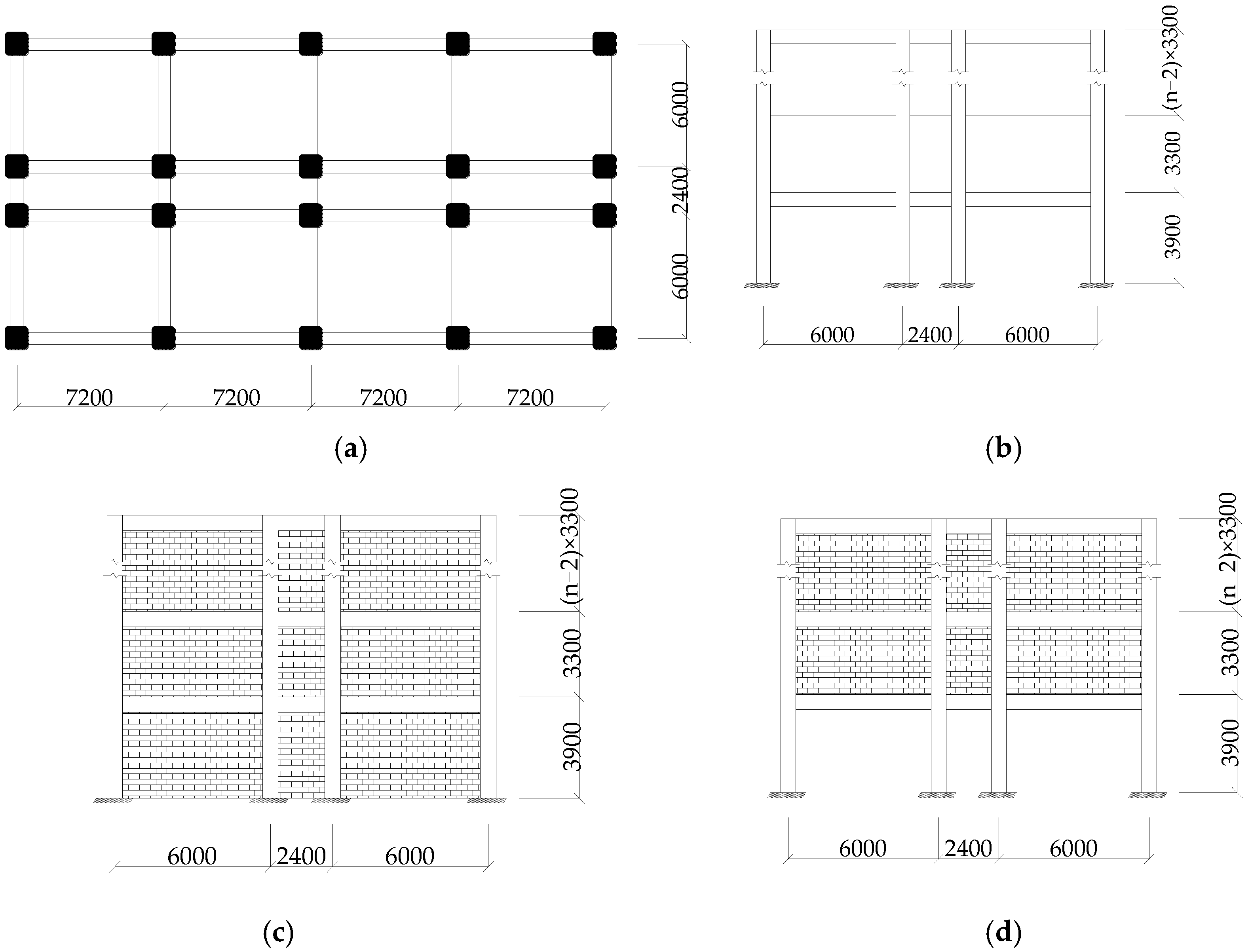


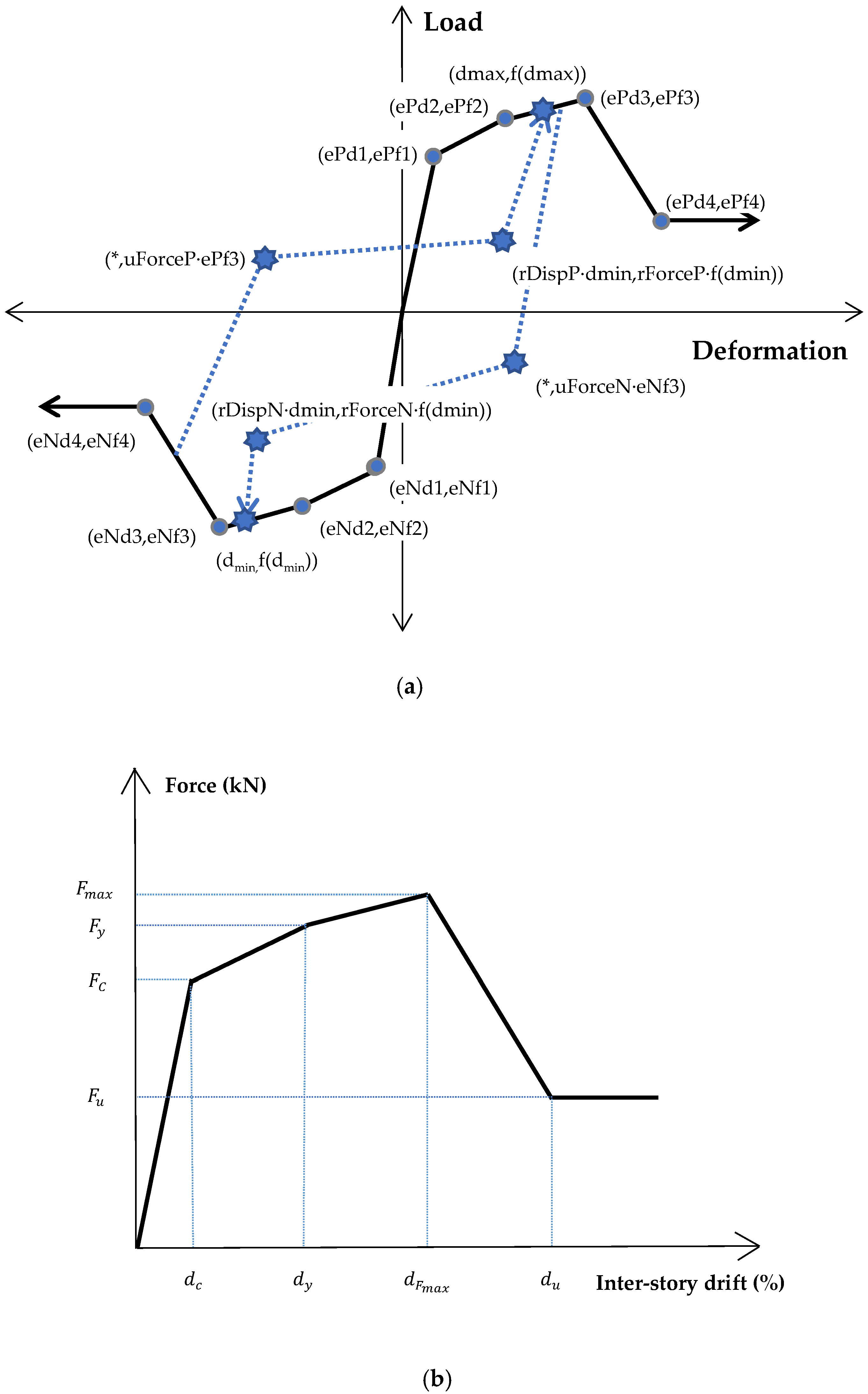



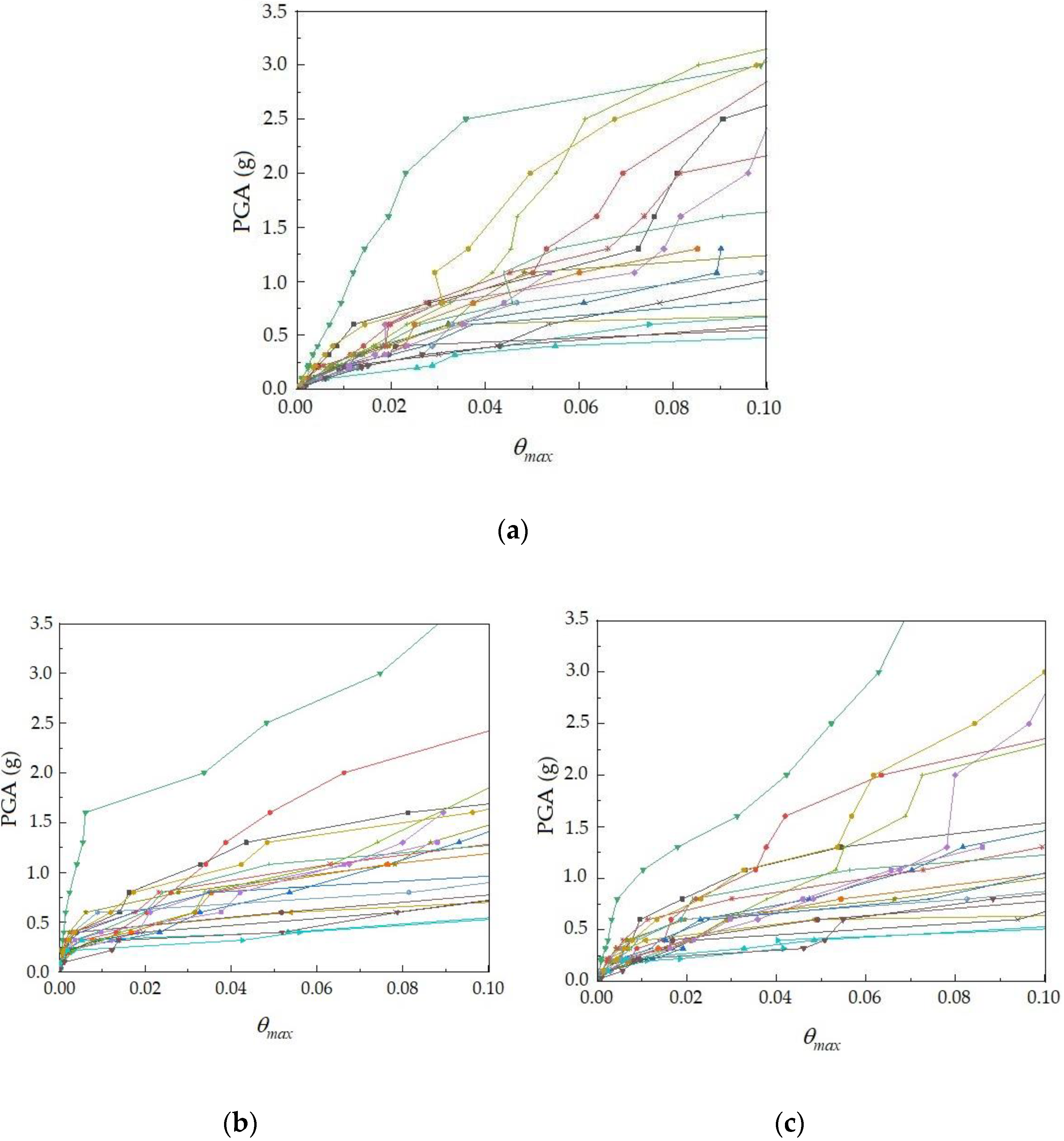
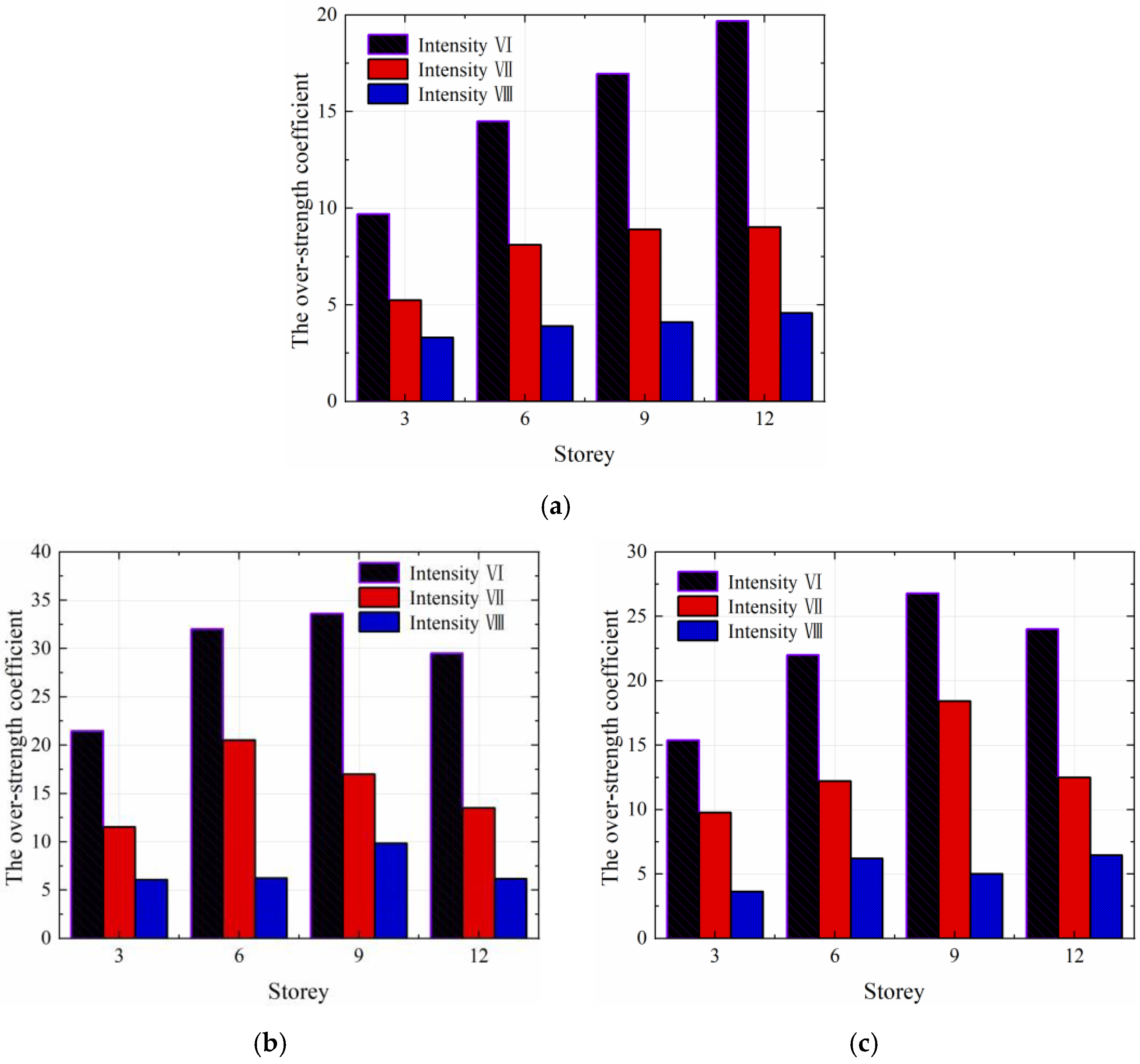
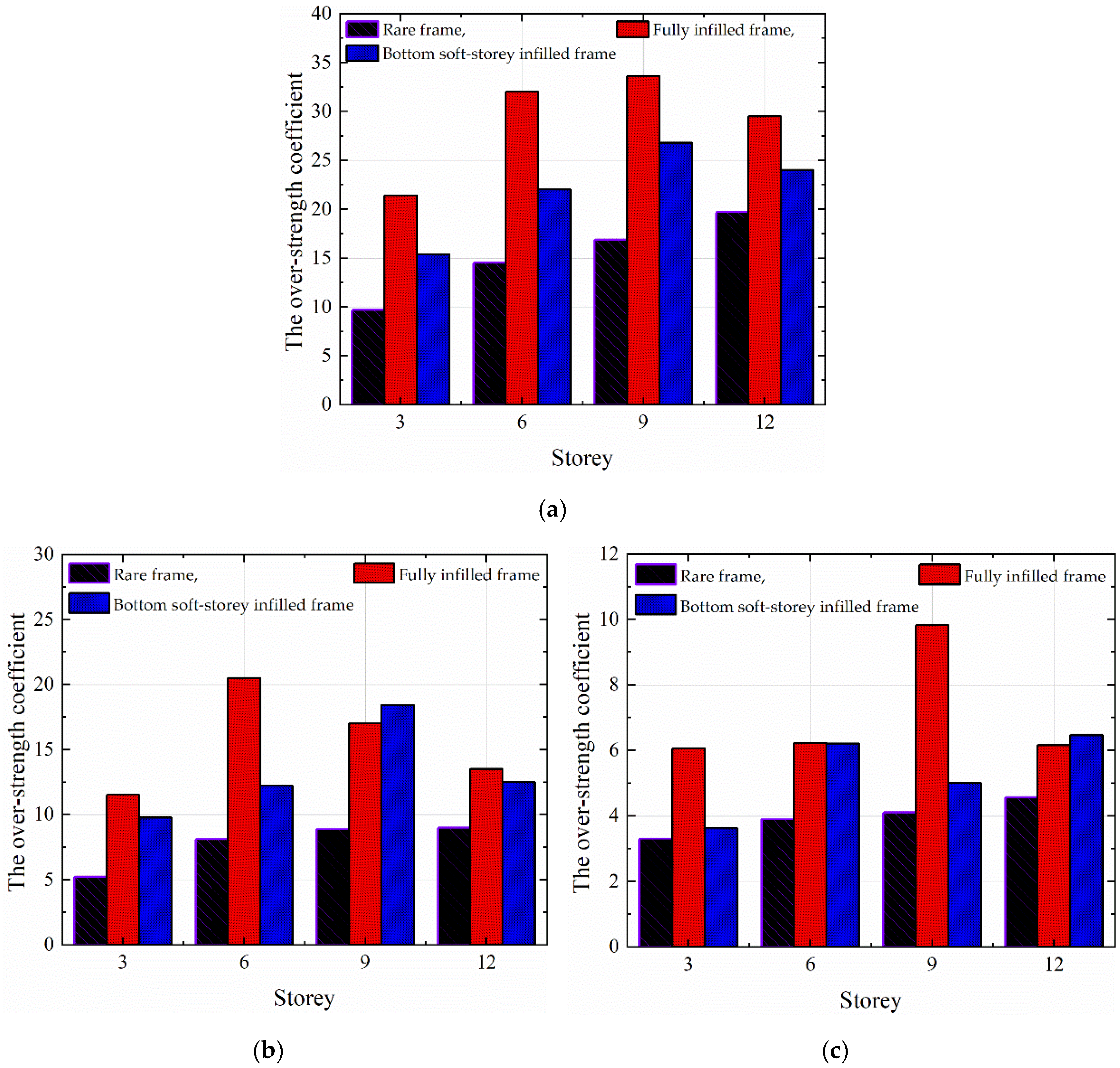

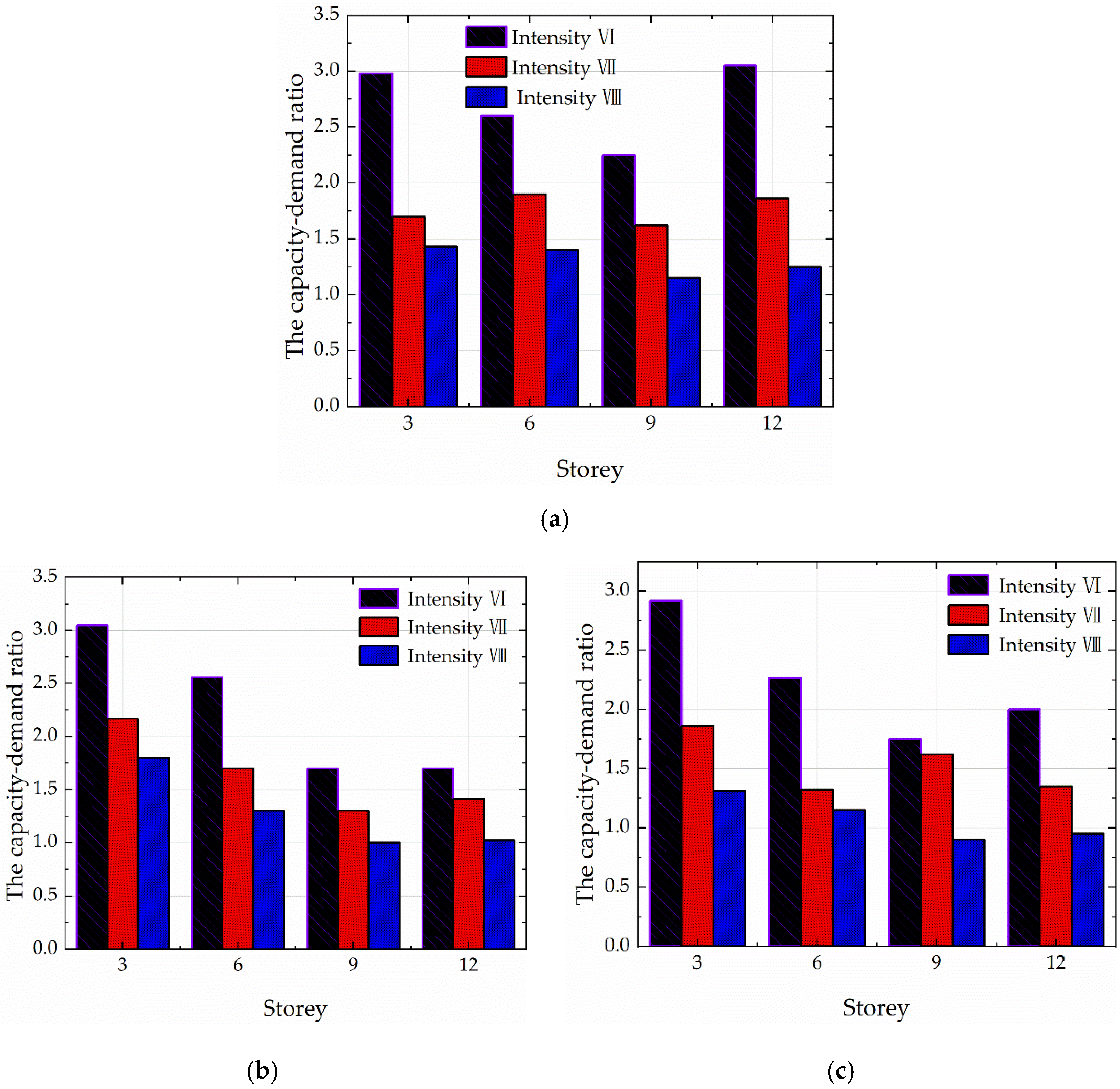
| Number of Stories | Story | The Section of Columns | The Section of Beams | ||
|---|---|---|---|---|---|
| bc (mm) | hc (mm) | bb (mm) | hb (mm) | ||
| 3 | 1~3 | 500 | 500 | 250 | 500 |
| 5 | 1~5 | 600 | 600 | 300 | 600 |
| 8 | 1~8 | 650 | 650 | 300 | 600 |
| 10 | 1 | 700 | 700 | 350 | 700 |
| 2~8 | 650 | 650 | 300 | 600 | |
| 9~10 | 600 | 600 | 300 | 600 | |
| 12 | 1 | 700 | 700 | 350 | 700 |
| 2~10 | 650 | 650 | 300 | 700 | |
| 11~12 | 600 | 600 | 300 | 600 | |
| Tar6 | Duz7 | |||||
|---|---|---|---|---|---|---|
| Initial Stiffness (kN/mm) | Residual Stiffness (kN/mm) | Peak Load (kN) | Initial Stiffness (kN/mm) | Residual Stiffness (kN/mm) | Peak Load (kN) | |
| Test | 63.77 | 50.63 | 588.96 | 48.70 | 28.03 | 763.35 |
| Numerical | 68.29 | 47.97 | 691.93 | 53.51 | 21.72 | 687.39 |
| Error | 7.09% | 5.26% | 17.48% | 9.86% | 22.51% | 9.95% |
| No. | Ground Motions | PGA (g) | PGV (cm/s) | PGD (cm) | PGA/PGV (g/(cm/s)) |
|---|---|---|---|---|---|
| GM-1 | RSN126_GAZLI_GAZ090 | 0.8639 | 67.62 | 20.71 | 0.0128 |
| RSN126_GAZLI_GAZ000 | 0.7017 | 66.18 | 27.32 | 0.0106 | |
| GM-2 | RSN160_IMPVALL.H_H-BCR230 | 0.7769 | 44.92 | 15.09 | 0.0173 |
| RSN160_IMPVALL.H_H-BCR140 | 0.5987 | 46.73 | 20.21 | 0.0128 | |
| GM-3 | RSN165_IMPVALL.H_H-CHI012 | 0.2699 | 24.79 | 9.29 | 0.0109 |
| RSN165_IMPVALL.H_H-CHI282 | 0.2542 | 29.89 | 7.65 | 0.0085 | |
| GM-4 | RSN495_NAHANNI_S1010 | 1.1079 | 43.90 | 6.80 | 0.0252 |
| RSN495_NAHANNI_S1280 | 1.2007 | 40.61 | 10.20 | 0.0296 | |
| GM-5 | RSN741_LOMAP_BRN000 | 0.4564 | 51.36 | 8.11 | 0.0089 |
| RSN741_LOMAP_BRN090 | 0.5023 | 44.47 | 5.05 | 0.0113 | |
| GM-6 | RSN181_IMPVALL.H_H-E06140 | 0.4473 | 66.99 | 27.88 | 0.0067 |
| RSN181_IMPVALL.H_H-E06230 | 0.4490 | 113.50 | 72.85 | 0.0040 | |
| GM-7 | RSN182_IMPVALL.H_H-E07140 | 0.3408 | 51.65 | 27.98 | 0.0066 |
| RSN182_IMPVALL.H_H-E07230 | 0.4691 | 113.08 | 46.92 | 0.0041 | |
| GM-8 | RSN292_ITALY_A-STU270 | 0.3205 | 71.92 | 29.31 | 0.0045 |
| RSN292_ITALY_A-STU000 | 0.2267 | 36.96 | 13.11 | 0.0061 | |
| GM-9 | RSN802_LOMAP_STG000 | 0.5145 | 41.56 | 16.32 | 0.0124 |
| RSN802_LOMAP_STG090 | 0.3262 | 45.95 | 33.31 | 0.0071 | |
| GM-10 | RSN828_CAPEMEND_PET000 | 0.5908 | 49.30 | 16.59 | 0.0120 |
| RSN828_CAPEMEND_PET090 | 0.6616 | 88.47 | 33.20 | 0.0075 | |
| GM-11 | RSN68_SFERN_PEL090 | 0.2248 | 21.71 | 15.91 | 0.0104 |
| RSN68_SFERN_PEL180 | 0.1949 | 16.93 | 12.87 | 0.0115 | |
| GM-12 | RSN125_FRIULI.A_A-TMZ000 | 0.3571 | 22.84 | 4.59 | 0.0156 |
| RSN125_FRIULI.A_A-TMZ270 | 0.3151 | 30.50 | 5.21 | 0.0103 | |
| GM-13 | RSN169_IMPVALL.H_H-DLT262 | 0.2357 | 26.31 | 14.69 | 0.0090 |
| RSN169_IMPVALL.H_H-DLT352 | 0.3497 | 32.98 | 20.17 | 0.0106 | |
| GM-14 | RSN174_IMPVALL.H_H-E11140 | 0.3668 | 36.00 | 25.08 | 0.0102 |
| RSN174_IMPVALL.H_H-E11230 | 0.3794 | 44.59 | 21.31 | 0.0085 | |
| GM-15 | RSN721_SUPER.B_B-ICC000 | 0.3573 | 48.05 | 19.27 | 0.0074 |
| RSN721_SUPER.B_B-ICC090 | 0.2595 | 41.77 | 21.85 | 0.0062 | |
| GM-16 | RSN725_SUPER.B_B-POE270 | 0.4750 | 41.15 | 7.73 | 0.0115 |
| RSN725_SUPER.B_B-POE360 | 0.2862 | 29.00 | 11.36 | 0.0099 | |
| GM-17 | RSN752_LOMAP_CAP000 | 0.5111 | 38.01 | 7.06 | 0.0134 |
| RSN752_LOMAP_CAP090 | 0.4386 | 29.60 | 4.91 | 0.0148 | |
| GM-18 | RSN767_LOMAP_G03000 | 0.5591 | 36.29 | 10.84 | 0.0154 |
| RSN767_LOMAP_G03090 | 0.3682 | 45.40 | 24.09 | 0.0081 | |
| GM-19 | RSN900_LANDERS_YER270 | 0.2445 | 51.10 | 41.69 | 0.0048 |
| RSN900_LANDERS_YER360 | 0.1518 | 29.08 | 23.13 | 0.0052 | |
| GM-20 | RSN953_NORTHR_MUL009 | 0.4434 | 59.27 | 15.47 | 0.0075 |
| RSN953_NORTHR_MUL279 | 0.4880 | 66.68 | 12.17 | 0.0073 |
| Number of Stories | 3 | 6 | 9 | 12 | ||||||||
|---|---|---|---|---|---|---|---|---|---|---|---|---|
| precautionary intensity | 6 | 7 | 8 | 6 | 7 | 8 | 6 | 7 | 8 | 6 | 7 | 8 |
| bare frame | 9.7 | 5.24 | 3.31 | 14.5 | 8.1 | 3.9 | 16.95 | 8.9 | 4.1 | 19.69 | 9.01 | 4.57 |
| fully infilled frame | 21.45 | 11.52 | 6.05 | 32 | 20.51 | 6.22 | 33.62 | 17 | 9.83 | 29.5 | 13.5 | 6.15 |
| bottom soft-story frame | 15.39 | 9.76 | 3.63 | 22 | 12.2 | 6.2 | 26.79 | 18.41 | 5 | 24 | 12.5 | 6.46 |
Publisher’s Note: MDPI stays neutral with regard to jurisdictional claims in published maps and institutional affiliations. |
© 2022 by the authors. Licensee MDPI, Basel, Switzerland. This article is an open access article distributed under the terms and conditions of the Creative Commons Attribution (CC BY) license (https://creativecommons.org/licenses/by/4.0/).
Share and Cite
Wang, X.; Su, Y.; Kong, J.; Gong, M.; Liu, C. The Over-Strength Coefficient of Masonry-Infilled RC Frame Structures under Bidirectional Ground Motions. Buildings 2022, 12, 1290. https://doi.org/10.3390/buildings12091290
Wang X, Su Y, Kong J, Gong M, Liu C. The Over-Strength Coefficient of Masonry-Infilled RC Frame Structures under Bidirectional Ground Motions. Buildings. 2022; 12(9):1290. https://doi.org/10.3390/buildings12091290
Chicago/Turabian StyleWang, Xiaomin, Yuhan Su, Jingchang Kong, Maosheng Gong, and Chunhui Liu. 2022. "The Over-Strength Coefficient of Masonry-Infilled RC Frame Structures under Bidirectional Ground Motions" Buildings 12, no. 9: 1290. https://doi.org/10.3390/buildings12091290






